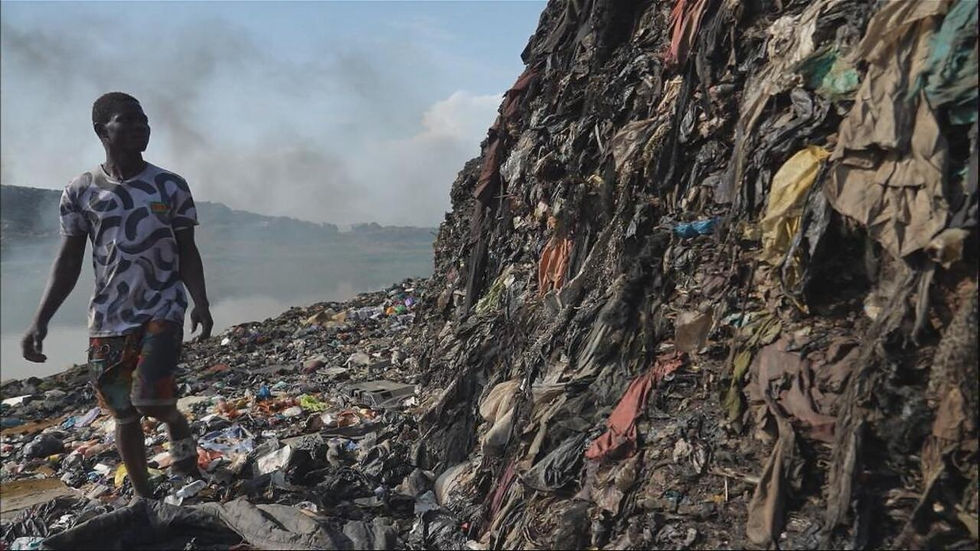Exports of used clothing end up in mountains of garbage.
- Paola Cano
- Jan 20, 2024
- 3 min read
Every second, a truckload of used clothing (from recycling bins, old clothes and overproduction) ends up in landfills, rivers or incinerators.
Greenpeace has documented the devastating consequences of fast fashion for people and the environment in countries such as Kenya and Tanzania.
An international agreement is needed that prohibits the export of textile waste and regulates designs so that they are truly recyclable, and a global tax that includes the polluter pays principle
Overproduction in the fast fashion industry is causing growing mountains of trash in the Global South. This is the result of intensive research by Greenpeace Germany. The Poison Gifts report (1) reveals how used clothing exports are also used to dispose of textile waste, which we are not able to manage in Europe. Shocking photos and videos document the devastating consequences for people and the environment in countries like Kenya and Tanzania: huge mountains of garbage polluting rivers and the air.

"The fast fashion industry has turned clothing into disposable items, just as we become accustomed to single-use plastics, we have become accustomed to single-use fashion," said Celia Ojeda-Martínez. , head of Biodiversity and Consumption at Greenpeace. “With this investigation, we have shown how countries and companies in the Global North are evading their responsibility when it comes to managing the enormous quantities of clothing that are not sold or are thrown away, many of them containing dangerous compounds. “They leave the people of East Africa alone with exported plastic and textile waste, without any infrastructure for its disposal.”
Old clothes and overproduction do not end up in stores, but in landfills. In Germany alone, more than one million tons of old clothing are collected every year. Less than a third is resold as second-hand items. In Spain, it is estimated that every year around 990,000 tons of textile products end up in landfills. However, textile recycling rates remain low: only 10-12% of post-consumer textile waste is collected separately for reuse and/or recycling, and less than 1% of total production is recycled in closed cycle, that is, with the same or similar use (2).
The Greenpeace study indicates that the majority of this used clothing is exported to Eastern Europe and Africa. But many items of clothing no longer have market value because they are defective, dirty or not suitable for the local climate. Research has shown that 30 to 40% of imports can no longer be sold or used. Along with the overproduction coming from everything that fast fashion cannot sell, these garments end up in landfills, in rivers or are incinerated in the open air, polluting the air and water. The figures are chilling: one truck per second of used clothing ends up in landfills, rivers or incinerators around the world.
According to the study, since the mid-90s the volume of clothing collected has grown by 20% each year, and the numbers continue to increase at the same rate as the production of fast fashion increases (7). But only a small percentage of this clothing is resold in the same country in which it is collected: between 10 and 30% in the United Kingdom, and only 8% in the US and Canada. It is estimated that more than 70% of UK reused clothing ends up abroad.
"It is not enough to write the word 'sustainable' on textiles or rely on false solutions such as recycling alone, we must change the business model," says Ojeda-Martínez. “As with the climate, we need an international agreement that bans the export of textile waste, regulates designs to be truly recyclable and encourages a circular economy, as well as a global tax that includes the polluter pays principle. “This means that the textile industry is financially responsible for the cost of cleaning up the environmental and health damage generated throughout the supply chain, that is, throughout the useful life of the product.”
A change is necessary in the textile sector and promoting alternatives such as slow fashion, the complete opposite of fast fashion. This week the Circular Sustainable Fashion Week is taking place in Madrid, which demonstrates how the textile sector can exist in a sustainable and socially fair way.
Contaminación textil ropa usada
Fuente: Greenpeace





Comments